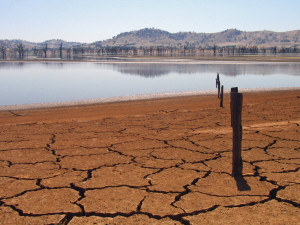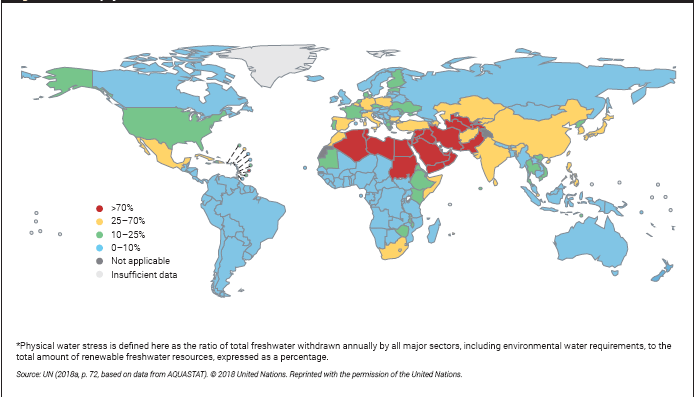Why Are We Ignoring the Warning Signs of Water Scarcity?
Mar 22nd, 2019 | By admin | Category: Water IssuesBy Suzanne York.
If humanity somehow survives the pending ecological collapse – driven by human impacts – future generations will wonder how it got so bad. It’s a rather simple explanation though. It is a combination of greed, ignorance and sticking our heads in the sand.
Case in point. Water, and water shortages in particular. Our most precious of resources, people, businesses and governments squander it with what seems to be little thought as to the consequences. Desert locales, from Las Vegas to Dubai to Perth, build oases in arid, rain-deprived regions, and more and more people come to live in areas meant for only a few.
The latest U.N. World Water Development Report, released in time for World Water Day, clearly stated the global challenges:
Water use has been increasing worldwide by about 1% per year since the 1980s, driven by a combination of population growth, socio-economic development and changing consumption patterns. Global water demand is expected to continue increasing at a similar rate until 2050, accounting for an increase of 20 to 30% above the current level of water use, mainly due to rising demand in the industrial and domestic sectors. Over 2 billion people live in countries experiencing high water stress, and about 4 billion people experience severe water scarcity during at least one month of the year. Stress levels will continue to increase as demand for water grows and the effects of climate change intensify.
The main UN website for the report (UNESCO) broke down the main drivers of water challenges as the following: extreme events, environmental degradation, population growth, rapid urbanization, unsustainable and inequitable consumption patterns, conflicts and social unrest, and unprecedented migratory flows.
Selected Statistics on Water
- About three out of 10 people, 2.1 billion, did not have a safely managed drinking water service at home in 2015, with only a quarter of sub-Saharan Africa covered. Of these, 844 million lacked a clean supply within a 30-minute round trip of where they lived.
- About 4 billion people – nearly two-thirds of the world population – experience severe water scarcity during at least one month of the year, a number expected to go up to 5 billion by 2050.
- The most water-stressed parts of the world are North Africa and the Middle East.
- Some 2.3 billion people, or one in every three people, did not have even a basic sanitation service in 2015, of which 892 million people still practiced open defecation.
- Worldwide, more than 80 percent of all wastewater goes back into the environment without being treated.
It is this combination of population growth, inequitable access, poor irrigation practices, misguided policies, big agriculture and industrial use of water that should make everyone think twice about global water priorities.
India and Day Zero for Water Scarcity
Take India, for instance. Home to 1 billion people, and a major exporter of agricultural products and textiles, it is facing a severe water crisis driven by human activities, overuse, inequitable access, and poor management practices, amongst other issues.
A recent report by WaterAid found that the rate of groundwater depletion in India jumped by 23 percent between 2000 and 2010. Nearly 1 billion of Indians live in water-scarce areas.
Earlier this week, two Indian water experts stated that the rate of groundwater extraction in India is so severe that research from NASA suggests that the water table is declining at a rate of about 0.3 meters per year. At this rate of depletion, India will have only 22 per cent of the present daily per capita water available in 2050, possibly forcing the country to import water.
Others experts have predicted that India could hit ‘day zero’ – a time when its water supply runs out – by 2020.
Incredibly, despite all of this, India is currently the world’s third largest exporter of groundwater.
![Himalayan cold desert in Sikkim (near India- Tibet border) with Chomo Yummo (6829 m). [photo credit: Wikimedia Commons]](http://populationgrowth.org/wp-content/uploads/2019/03/Himalayan_Cold_Desert_-_North_Sikkim.jpg)
Himalayan cold desert in Sikkim (near India- Tibet border) with Chomo Yummo (6829 m). [photo credit: Wikimedia Commons]
Compounding this dire situation is the melting of the Himalayan glaciers, due to climate change. Even if the Paris climate goals were somehow miraculously met, climate change will melt a third of the ice in the Himalayan glaciers by 2100. And if the climate goals are not achieved, two-thirds of the region’s glaciers could be gone by the end of this century. Approximately 1.9 billion people, or about a quarter of the world’s population, depend upon the fresh water that flows from the Himalayan glaciers for drinking water, agriculture and energy needs.
According to WaterAid, the world’s water crisis is getting worse, yet globally we use six times as much water today as we did 100 years ago, driven by population growth and changes in diets and consumer habits (emphasis added).
Too Many Being Left Behind
The UN water report is titled Leaving No One Behind. But if we don’t get a handle on overexploitation of resources, overconsumption, inequity and a still growing population, many people will be left behind to grapple with the outcome of ignoring the obvious signs of overreach.
And what about all of the other species with whom we share the planet?
Suzanne York is Director of Transition Earth.


